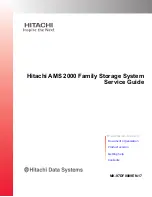
Travelstar 5K160 (SATA) Hard Disk Drive Specification
65/167
12.15
Software Setting Preservation Feature Set
When a device is enumerated, software will configure the device using Set Features and other
commands. These software settings are often preserved across software reset but not necessarily
across hardware reset. In Parallel ATA, only commanded hardware resets can occur, thus legacy
software only reprograms settings that are cleared for the particular type of reset it has issued. In
Serial ATA, COMRESET is equivalent to hard reset and a non-commanded COMRESET may occur
if there is an asynchronous loss of signal. Since COMRESET is equivalent to hardware reset, in the
case of an asynchronous loss of signal some software settings may be lost without legacy software
knowledge. In order to avoid losing important software settings without legacy driver knowledge,
the software settings preservation ensures that the value of important software settings is
maintained across a COMRESET. Software settings preservation may be enabled or disabled using
Set Features with a subcommand code of 06h. Software settings preservation is enabled by default.
12.15.1
Preserved software settings
If Software setting preservation is enabled, the following settings are preserved across COMRESET.
Otherwise settings are cleared across COMRESET.
Setting Contents
Track length
Number of head
Number of cylinder
Initialize device parameters
Capacity
Power Management Feature Set Standby Timer
Time to fall into standby mode
Security freeze lock
Security mode state
Security unlock
Set max address
Capacity
Write Cache Enable/Disable
Set Transfer Mode
Advanced Power Management Enable/Disable
Read Look-Ahead
Set feature
Reverting to Defaults
Set multiple mode
Block size
Figure 19 Preserved Software Setting
12.16
Native Command Queuing
Native Command Queuing feature (Read / Write FPDMA Queued commands) is supported. Please
refer to the Serial ATA II Specification about Native Command Queuing.
The host shall not issue a legacy ATA command while a native queued command is outstanding.
Upon receiving a legacy ATA command while a native queued command is outstanding, the device
aborts the command and halts command processing of outstanding native queued commands.
















































